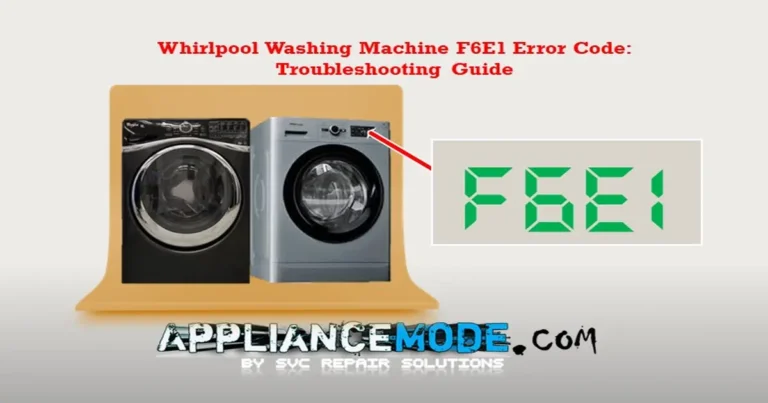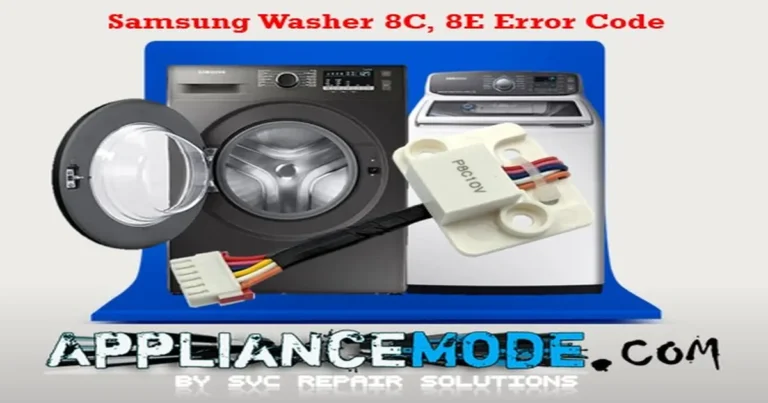Dealing with the Midea top load washer E1 error code? No worries—we’ve got the scoop on fixing it! In this post, we’ll break down what the E1 error means, go through the common causes, and share simple steps to troubleshoot and solve the issue.

Let’s dive in and get your Midea washer back on track! #MideaWasherFix #E1ErrorSolved
Midea Top Load Washer E1 Error Code: Unveiling the Meaning, Causes, and Simple Solutions
Understanding the Midea Top Load Washer E1 Error
The E1 error code on a Midea top-load washer is a clear indicator of a water filling issue. In technical terms, it signifies a “Water Inlet Valve Error,” pointing to the failure of the water level to reach the set level within a specified time or minimal water level change during the filling process. Essentially, if the inlet valve operates for 10 minutes without reaching the target water level, the E1 error will appear.
Common Causes of the E1 Error and Solutions:
- Faucet not turned on:
- Issue: Ensure the faucet supplying water to the washer is turned on.
- Solution: Confirm the water source is open by turning on the faucet.
- Bent-inlet hose:
- Issue: Check if the inlet hose is bent, hindering smooth water flow.
- Solution: Inspect the inlet pipe for bends and adjust any deformities.
- Low water pressure:
- Issue: Unscrew the inlet pipe, turn on the faucet, and check for low water pressure or ongoing water outages.
- Solution:
- Verify adequate water pressure and address any water supply issues.
- Low water pressure in your home. Consult a plumber if this is a recurring issue.
- Wiring issues with the inlet valve:
- Issue: The wiring may be disconnected or broken.
- Solution:
- Initial Inspection:
- Visually inspect the inlet valve for any signs of physical damage, such as cracks, leaks, or corrosion. If you find any damage, replace the valve immediately.
- Check for any loose or disconnected wiring connected to the valve. Ensure all connections are secure.
- Testing for Power and Function:
- Carefully touch the inlet valve during the water inlet state (while the appliance is activated to fill with water).
- If you feel a distinct vibration or hum, it indicates the valve is likely receiving power and attempting to operate. Proceed to step C.
- If you feel no vibration or only a very weak hum, proceed to step D.
- Troubleshooting Valve Function:
- Use a multimeter to measure the AC voltage at the valve terminals.
- If AC voltage is present within the expected range (usually around 120V or 240V, depending on your region), but the valve is not working correctly, it suggests an internal fault within the valve itself. Replace the inlet valve.
- If the AC voltage is not present or is significantly lower than expected, proceed to step D.
- Checking for electrical issues:
- Use a multimeter to check for continuity in the wiring harness leading to the valve. This helps identify any breaks or shorts in the wiring.
- If you find a break or short in the wiring, repair or replace the wiring harness as needed.
- Initial Inspection:
- Inlet valve filter screen blockage:
- Issue: The inlet valve filter screen may be blocked.
- Solution:
- If the valve appears to be working but the appliance is not filling correctly, check for:
- Clogged screens or filters within the valve may be restricting water flow.
- Remove the inlet hose, clean any debris from the filter screen, and reinstall.
- If the valve appears to be working but the appliance is not filling correctly, check for:
Additional Issues Related to Water Leakage:
- Water leakage from the tub:
- Issue: Check for damaged or leaking points on the water tank and clutch installation.
- Solution: Replace damaged components causing water leakage.
- Drain Valve Core Leakage:
- Issue: Unintended water discharge during filling: Water is being discharged while the filling process is active, resulting in simultaneous inflow and outflow. This impedes complete and efficient filling.
- Solution:
- Inspect the drain valve core.
- Visually examine the drain valve core for any signs of damage, debris, or improper seating.
- Manually test the valve’s ability to close fully and securely.
- Clean or replace the valve core.
- If the valve core is dirty or worn, clean it thoroughly according to the manufacturer’s instructions.
- If cleaning is ineffective or damage is observed, replace the valve core with a compatible part.
- Additional recommendations:
- Check for leaks: Inspect the entire system for any leaks or loose connections that could contribute to water loss.
- Monitor the filling process: Closely observe the filling process to detect any abnormal discharge or prolonged filling times.
- Inspect the drain valve core.
- Water Level Sensor Malfunction:
- Issue: The water level sensor may malfunction.
- Solution:
- Check for leaks, blockages, or bends in the pressure hose and air chamber.
- If the water level is close to or above the balance ring, replace the water level sensor.
- PCB Damage:
- Issue: The computer board (main PCB) may be damaged.
- Solution: Check for PCB damage; if found, replace the computer board.
Conclusion:
Tackling the Midea top load washer E1 error code is all about addressing common water filling issues. By ensuring a functional faucet, checking for hose bends, maintaining proper water pressure, and inspecting vital components like the inlet valve, you can swiftly troubleshoot and resolve the E1 error.

I am a master Appliance Repair technician with over 35 years of experience in the field. I am passionate about helping people troubleshoot their appliances and fix common problems. My website, appliancemode.com, provides a wealth of information on troubleshooting common appliance issues and deciphering error codes. This website aims to empower people to tackle appliance repairs themselves and save money on service calls.



